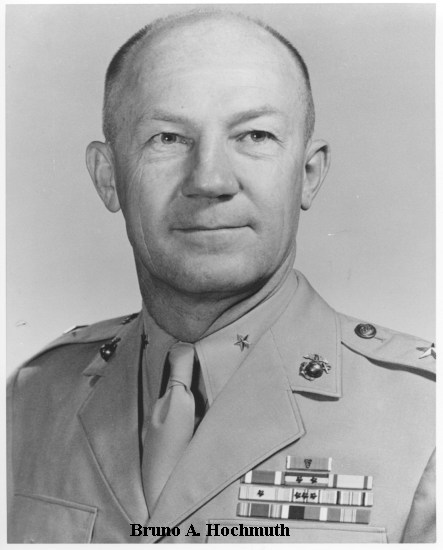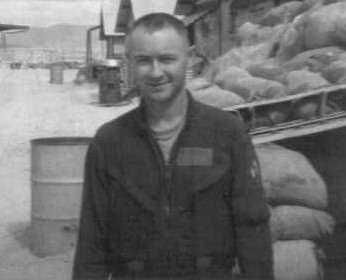Death of MajGen. Bruno A. Hochmuth

The statement below,
by Maj. John A. “Al” Chancey, was submitted to the Board which was convened
to conduct an investigation into the death of MajGen. Bruno A. Hochmuth,
CG 3rdMARDIV in November 1967.
| Statement of Major John A. Chancey, 077369, USMC
On
14 November 1967, I was assigned to fly admin chase for a VMO-3 UH-1E.
My mission number was #58, and was authorized by MAG-36 Frag Order number
14-21. My event number was Swift 4-1. I was briefed by the
HMM-364 Operations Duty Officer (ODO) on assigned frequencies, call signs
and the nature of the mission, and was instructed to stand by until further
notice. I received my aircraft assignment, preflighted it, warmed
up the engine and returned to the Ready Room to await further word.
At approximately 0915 I received instructions from the ODO to launch and
chase the UH-1E (Scarface 1-0) on a road recon down highway #1 to the 124
radial at 13 miles (124/13) from Phu Bai TACAN. I turned up on the
assigned frequency and contacted Scarface 1-0. We joined up and proceeded
to a bridge site at 124/13 miles from Phu Bai, where the UH-1E landed but
did not shut down. After about 5 minutes on the ground, during which
time I stayed at 1500 feet, the UH-1E lifted and we returned to Phu Bai,
landed and refueled. The UH-1E advised me that we had a VIP pickup
at the 3rd MARDIV CG pad at 1045 and that we would turn up at 1040.
I then proceeded to the HMM-364 flight line across the runway and shut
down. I then changed aircraft because of an inoperative FM radio,
preflighted again and turned up at 1040. I have no knowledge of the
actions of the UH-1E pilots during this time because of our separate locations.
We established communications at 1040, the UH-1E (Scarface 1-0) called
for a formation take-off and we proceeded to the CG pad at 3rd MARDIV.
I orbited overhead while the UH-1E landed and picked up General Hochmuth’s
party. We then flew directly to the RVN hospital pad at Hue (about
10 minutes flight time) and shut down both aircraft for about 45 minutes.
Both pilots and crew chief were with the UH-1E during this time, and I
observed no other person approach the aircraft except my own co-pilot,
1stLt. Darger.
The General's party arrived back at the aircraft about 1145 and we departed
north along highway #1 toward Dong Ha, our next destination. We leveled
off just underneath the overcast at approximately 1500 feet and about 90
knots airspeed. About 5 minutes after take-off, at 1150, the UH-1E
yawed slightly right and left and at the same instant exploded in mid air.
The explosion appeared to emanate from the center portion of the aircraft
(engine and aft cabin area). The whole aircraft was immediately engulfed
in a large fire ball and dense black smoke. The fuselage separated
from the rotor, and fragments flew in all directions. The rotor appeared
to remain intact and the burning fuselage fell away in a near vertical
descent. Because of the dense smoke and my evasive action to fly
clear of the falling debris, I was unable to observe the maneuvers of the
fuselage on the way down or the impact.
I transmitted the crash position (300/12 miles from Phu Bai) and the circumstances
on guard channel and then descended to see if I could detect any survivors
or assist. The fuselage was still burning although it was almost
completely submerged in a flooded rice paddy. We hovered around the
wreckage for 5-10 minutes but found no evidence of survivors. The
crew chief spotted a hard-hat about 100 meters from the fuselage and I
hovered with the helicopter's wheels in the water while he debarked and
retrieved it, but he was unable to find any survivors in the vicinity.
We then climbed back to altitude and transmitted our observations on guard.
We remained in the area until other aircraft were dispatched to relieve
us on station.
I observed no weapons fire at the time of the explosion, nor did I receive
any fire while hovering around the crash scene.
/s/ John A. Chancey
Major
USMC
|
Al Chancey reflects on the incident 38 years later:
This was my first flight
as a Helicopter Aircraft Commander (HAC) since arriving in Vietnam 29 October
1967, although I had flown several missions as copilot with in-country
pilots from another squadron. Since this was my first real combat tour
I wasn't sure what to expect, but was hopeful my Marine Corps training
had prepared me well for the job and would keep me from embarrassing myself
in front of the people I had come to respect so highly. Anyway, we would
be here for 13 months and I would have ample time to gain experience and
prepare myself for whatever was ahead. As it turned out I didn't have much
time at all.
 Maj. John A. "Al" Chancey
Maj. John A. "Al" Chancey
|
 1stLt. "Rocky" Darger
1stLt. "Rocky" Darger
|
The
flight schedule for the day, 14 Nov 1967, was especially accommodating
to someone who had been in-country only two weeks and flying for the first
time as a HAC in Vietnam. Mission #58 was an admin flight-- and a VIP admin
flight to boot. The General would visit outlying units, giving us
an opportunity to become more familiar with the area. Lt. “Rocky”
Darger and I, along with a crew chief and gunner from HMM-263, would be
flying chase on a UH-1E, piloted by qualified VIP pilots who would do the
navigation and make the radio calls—a chance to watch, listen and learn.
But I could never imagine how quickly I would come face to face with the
painful realities of flying helicopters in combat. And among the
things I learned this day was that there is nothing to prepare you for
seeing an aircraft filled with Marines falling to earth in a ball of fire.
The first reaction is unimaginable shock at the sight of an aircraft exploding
in mid air only a few yards away, but the shock is momentarily tempered
by total disbelief and the urgent action to avoid the debris. More
lasting is the overpowering feeling of helplessness as the aircraft tumbles
to earth and you realize you are witness to the last agonizing moments
of life for the five Marines on board. Only later does the profound
sadness settle into the pit of your stomach along with the nausea it creates.
Even today, 38 years later, I often think of these few good Marines and
what they might have done with their lives, and I pray that the loved ones
they left behind have found peace.
Upon being relieved
on station by other aircraft we returned to the flight line at Phu Bai
and shut down. By late afternoon the recovery team and security forces
that were inserted were ready to be extracted and Lt. Darger and I joined
a flight of four aircraft to help with the extraction. When we returned
to the flight line and shut down this time we thought the harrowing day
was finally over. Instead we were immediately escorted to a GP tent
filled with flood lights, TV cameras and reporters with microphones and
a steady barrage of leading questions. At this time the anti-war
movement was at a peak in the US and it seemed the press just needed confirmation
that the war was being lost. One reporter even tried to get Lt. Darger
to admit that the crash was caused by a suicide attack carried out by an
ARVN officer who was on the helicopter. There was an ARVN liaison officer
aboard, Maj. Nguyen Ngco Chuong, but BGen. Robert Keller’s report attributed
the crash to a tail rotor gearbox failure. The story, of course, was headline
news in the papers and on TV back in the US where our families lived, including
the much edited interview at Phu Bai. Even before the story broke
a local reporter picked it up on the wire services and called my wife,
who was one week away from delivering our son, and told her that her husband
was involved in a helicopter crash that killed a general and wanted to
know if she had any additional information. She knew nothing about the
incident at the time and was obviously quite traumatized.
Additional Notes:
Since HMM-364 was a
CH-46D squadron in 1967, some may wonder why I felt a need to warm up the
engine as part of the preflight procedure on 14 Nov 1967. As everyone
knows, jet engines don't need warming up. So here is the rest of the story.
When HMM-364’s main body departed MCAS El Toro by C-141 on 28 Oct 1967
the squadron's CH-46D’s were still undergoing combat modifications and
structural modifications to prevent the tails from continuing to fall off
at inopportune times. A rear echelon was left behind to continue the modifications.
On Nov 10, the 32 aircraft, the squadron's equipment and the remaining
personnel were loaded aboard the USS Valley Forge (LPH-8) bound for Vietnam.
Meanwhile, HMM-364 personnel had moved into tents placed along a dirt taxi
way on the east side of the runway at Phu Bai, where we slogged through
ankle deep mud and got blowing dust in our eyes at the same time. Since
HMM-364 had lots of pilots and no aircraft 1stMAW decided to transfer all
of HMM-263’s assets to HMM-364. Don't know how much consideration was given
to the fact that HMM-263 was a UH-34D squadron. In any event, those
HMM-364 pilots who had previous experience in the UH-34D started flying
missions in the “Dog”. As soon as they accumulated the minimum number
of hours for recertification they were designated HAC in the UH-34D.
The pilots of HMM-364 flew the UH-34D for the entire month of November,
sometimes with the HMM-263 assets that had been acquired and sometimes
as augmentation pilots with HMM-362. The squadron was finally reunited
with its CH-46D’s on 29 Nov 1967.
And
that's why I elected to warn up the engine as part of the preflight routine
on 14 Nov 1967, and why Lt Darger and I were in the cockpit of a UH-34D
when we watched in horror as MajGen. Hochmuth’s aircraft exploded in mid
air at 1500 feet just north of HueCity.
After Action Report
#1
After Action Report #2
After Action Report #3
Back Browser or Home
.



